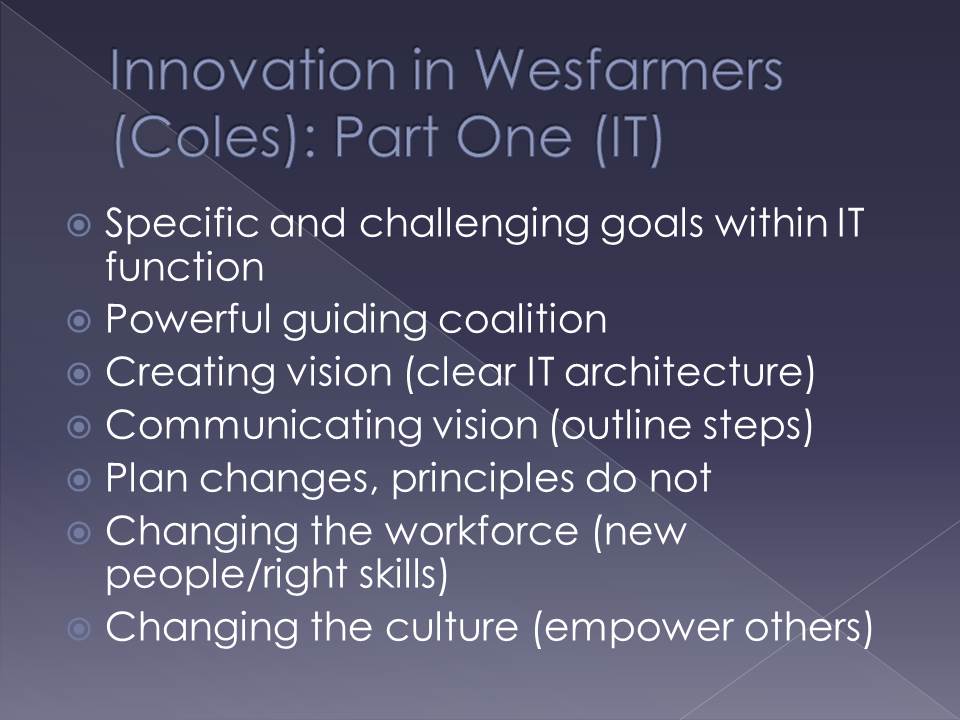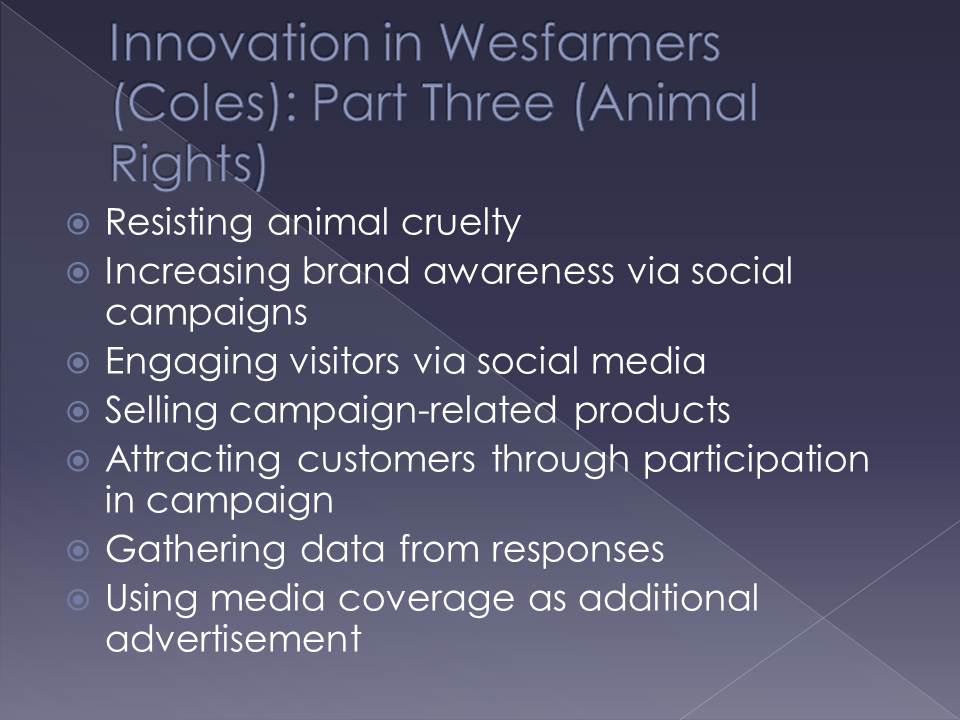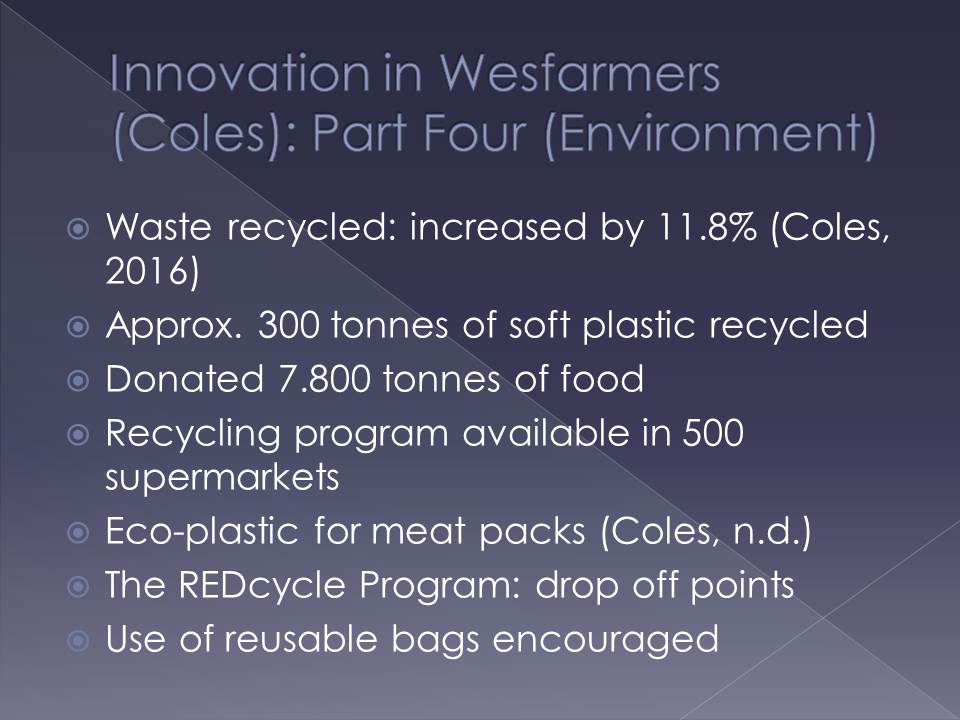Innovation in Wesfarmers (Coles): Part One and Two (IT)
- Specific and challenging goals within IT function;
- Powerful guiding coalition;
- Creating vision (clear IT architecture);
- Communicating vision (outline steps);
- Plan changes, principles do not;
- Changing the workforce (new people/right skills);
- Changing the culture (empower others).
The innovation in IT at Coles was necessary due to the business transformation. The company’s CIO Mahler pointed out that to implement change, challenging goals within IT function were necessary (Fang, Kosev, & Wakeling, 2014; Seddon, Reynolds, Willcocks, & Mahler, 2012). Creating a sense of purpose and forming a powerful coalition within IT function also allowed the company to implement innovation successfully. Mahler created the company’s vision in IT, communicated it, outlined the steps of transformation, and stressed that the plan itself could change, but the principles of the transformation and IT would not (Seddon et al., 2012). Attracting new people with the right skills and empowering the workforce were also important in implementing innovation.
- Investing in relationships;
- Delivering a visible showcase;
- Focusing on change in each business area;
- Separating projects;
- Stop IT change requests (Drucker, 2014);
- Communicate with the top;
- Focusing on business outcomes.
The company’s CIO also stated that the business had to invest in supplier relationships by developing closer relationships with fewer suppliers (Seddon et al., 2012). Planning short-term wins and delivering visible showcases to make the IT employees more proud of their work was also perceived as crucial by the CIO. The change should have been implemented in each business area, but the projects were separated for better control. IT change requests slowed down the process and were stopped. The CIO communicated with the top managers of the company to create more engagement; the workforce focused on business outcomes and not IT workforce savings or efficiency.


Innovation in Wesfarmers (Coles): Part Three (Animal Rights)
- Resisting animal cruelty;
- Increasing brand awareness via social campaigns;
- Engaging visitors via social media;
- Selling campaign-related products;
- Attracting customers through participation in campaign;
- Gathering data from responses;
- Using media coverage as additional advertisement.
Coles took part in Animals Australia campaign against animal cruelty (Animals Australia, 2013). The brand awareness rose due to the extensive campaign presence in social media (YouTube, Twitter, Facebook) and sales of the “winged pig” shopping bags (Mummery, Rodan, Ironside, & Nolton, 2013). According to the company, it received thousands of emails (approx. 3000 or more) that approved their decision to take part in the campaign dedicated to animal rights. A variety of newspapers such as Sydney Morning Herald, Courier Mail, The Australian, Daily Telegraph, etc. covered the company’s participation in the campaign, which eventually attracted more attention to Coles (Mummery et al., 2013).

Innovation in Wesfarmers (Coles): Part Four (Environment)
- Waste recycled: increased by 11.8% (Coles, 2016);
- Approx. 300 tonnes of soft plastic recycled;
- Donated 7.800 tonnes of food;
- Recycling program available in 500 supermarkets;
- Eco-plastic for meat packs (Coles, n.d.);
- The REDcycle Program: drop off points;
- Use of reusable bags encouraged.
In 2016, the amount of waste recycled by the company increased by 11.8%. The customers returned approximately 300 tonnes of plastic that were recycled by Coles. Furthermore, almost 8.000 tonnes of food were donated by the company to those in need. The recycling program is available for every customer in 500 supermarkets; customers can also use drop off points to recycle bags, cereal and food packages, and other items. Coles uses eco-plastic for meat products; it is produced from recycled materials and is recyclable. Coles sells and encourages the use of plastic bags (produced by Coles or any other company).

References
Animals Australia. (2013). Coles extends commitment to pigs – and hens. Web.
Coles. (n.d.). Waste. Web.
Coles. (2016). Reducing our environmental impact. Web.
Drucker, P. (2014). Innovation and entrepreneurship. London, England: Routledge.
Fang, A., Kosev, M., & Wakeling, D. (2014). Trends in Australian corporate financing. JASSA, 4(1), 22-35.
Mummery, J., Rodan, D., Ironside, K., & Nolton, M. (2014). Mediating legal reform: Animal law, livestock welfare and public pressure. Web.
Seddon, P. B., Reynolds, P., Willcocks, L. P., & Mahler, P. (2012). How to succeed in the transformation of an IT function: Lessons from Coles Myer Limited. Web.